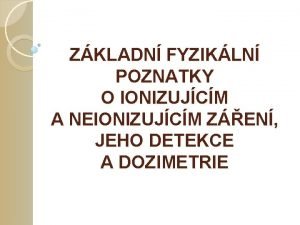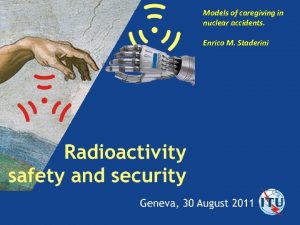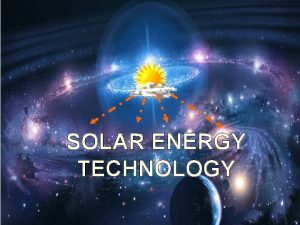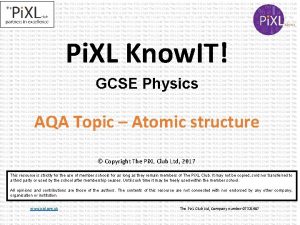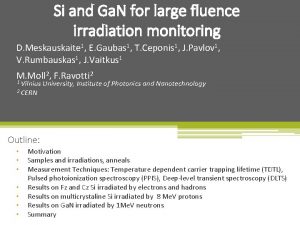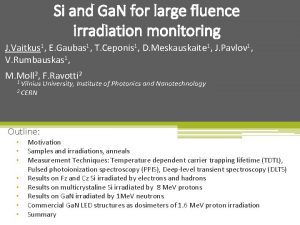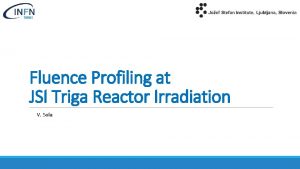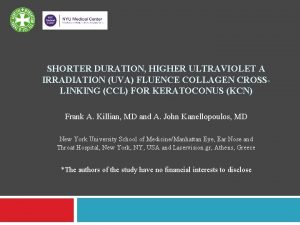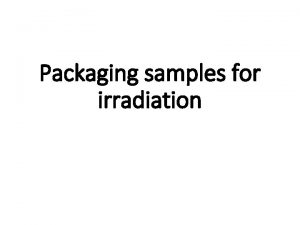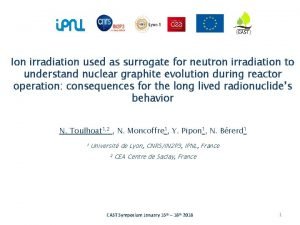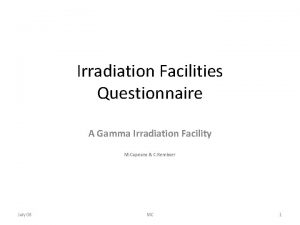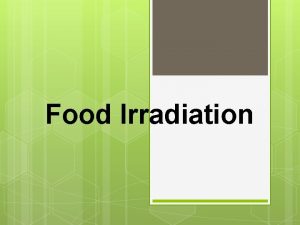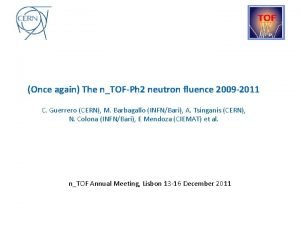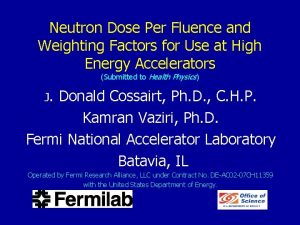Ga N for large fluence irradiation monitoring J













- Slides: 13

Ga. N for large fluence irradiation monitoring J. Vaitkus, E. Gaubas, T. Ceponis, J. Pavlov, V. Rumbauskas 1 Vilnius 2 CERN University, Institute of Photonics and Nanotechnology Outline: WP 15 task for VU: contribution to radiation monitoring & imaging. • • • Motivation Characterization techniques Results on AT Ga. N Commercial Ga. N LED structures as dosimeters Summary. AIDA 2020 Fourth annual meeting, Oxford, 2019. 04. 02 -05

The devices for integrated fluence monitoring and radiation field imaging based on Si properties To remind previous contributions The device for the contactless fluence monitoring delivered to CERN. The “trapping” time Si AIDA 2020 Fourth annual meeting, Oxford, 2019. 04. 02 -05 The device for 2 D integrated fluence imaging up to 3“.

Ga. N promise Variations of the current transients (in J. Grant et al J. Vaitkus et al. / NIMA 576 (2007) 60– 65 the tentative detectors made of Ga. N: Mg and Ga. N: Mn for the 290 fs laser pulses at 315 nm wavelength excitation) dependent on AIDA 2020 Fourth annual meeting, Oxford, 2019. 04. 02 -05 neutron irradiation fluence.

Characterization techniques (1): ● Pulsed photoionization spectroscopy (PPIS) • The PPIS were implemented using excitation by a tuneable wavelength laser and measurements of the photo-response by applying microwave probed photoconductivity transient (MW-PC) technique. • Tuneable wavelength femtosecondnanosecond lasers (210 to 2300 nm) were employed. AIDA 2020 Fourth annual meeting, Oxford, 2019. 04. 02 -05 4

Characterization techniques (2): ● Pulsed barrier evaluation by linearly increased voltage (BELIV) ● Proton induced luminescence spectroscopy (PIL) ● TCT AIDA 2020 Fourth annual meeting, Oxford, 2019. 04. 02 -05 5

Results on AT Ga. N irradiated by 1 Me. V neutrons Non-irradiated Ga. N: Mg Photoactivation energy (e. V) Ga. N: Mg Ga. N: Mn • AIDA 2020 Fourth annual meeting, Oxford, 2019. 04. 02 -05 Irradiated with Φ=1016 cm-2 Photoactivation energy (e. V) Γ Γ Defect type EMn-1=1. 40 0. 05 EMn-1 irr=1. 42 0. 08 Mn related EMn-2=1. 98 0. 25 EMn-2 irr=1. 98 0. 22 Might be oxygen related EMn-3=2. 40 0. 15 EMn-3 irr=2. 37 0. 25 Ga. I or NI EMn-4=2. 97 0. 25 EMn-4 irr=2. 96 0. 28 Unidentified EMg-1=1. 30 0. 02 − − Donor/acceptor state EMg-2=1. 70 0. 15 EMg-1 irr=1. 71 0. 22 VNMg. Ga EMg-3=2. 07 0. 23 EMg-2 irr=2. 05 0. 27 VGa EMg-4=2. 39 0. 15 EMn-3 irr=2. 37 0. 25 Ga. I or NI − − EMg-4 irr=2. 45 0. 16 Unidentified or NI EMg-5=3. 00 0. 32 EMg-5 irr=3. 00 0. 35 Unidentified EMg-6=3. 30 0. 2 EMg-6 irr=3. 30 0. 27 Mg. I 6

AT Ga. N (a) -Variations of cross-sections of the photon-electron coupling and of trap concentration as a function of excitation photon energy in the pristine AT-grown Ga. N samples doped with Mg and Mn. Vertical arrows indicate the peak positions of the PPIS steps, ascribed to different centres. (b) – Variations of the predominant TR-PL spectral peaks with neutron irradiation fluence. In the inset (i) variations of TR-PL spectra are depicted. (The excitation - 290 fs laser pulses, 315 nm wavelength) E. Gaubas, T. Čeponis, et al, “Pulsed photo-ionization spectroscopy of traps in as-grown and neutron irradiated ammonothermally synthesized Ga. N”, www. nature. com/scientificreports; Scientific Reports (2019) 9: 1473 AIDA 2020 Fourth annual meeting, Oxford, 2019. 04. 02 -05

Ga. N LED-based structures for remote dosimetry Evolution of the BELIV current transients for the reverse (a) and forward (b) biased Ga. N LED ( PL = 45 s). (a) LED irradiated with the proton fluences of 0 (1); 5 1014 p/cm 2 (2); 8 1014 p/cm 2 (3); 1 1015 p/cm 2 (4); 2 1015 p/cm 2 (5); 3 1015 p/cm 2 (6); and 5 1015 p/cm 2 (7), respectively (UP, R = 6 V). (b) Pristine LED (1 -3) and LED irradiated with the fluence of 5 1015 p/cm 2 (1 – 3 ) for peak voltage UP, F of 1 V (1 and 1’), 2 V (2 and 2’), and 3 V(3 and 3’). E. Gaubas, T. Ceponis, D. Meskauskas, J. Pavlov, A. Zukauskas, V. Kovalevskij, V. Remeikis Sensors and Actuators A 267 (2017) 194– 199 AIDA 2020 Fourth annual meeting, Oxford, 2019. 04. 02 -05 8

Ga. N LED-based structures for remote dosimetry TCT transients (a) and peak-current (b) as a function of reverse-bias voltage measured on pristine and heavily irradiated LED-based sensor. E. Gaubas, T. Ceponis, D. Meskauskas, J. Pavlov, A. Zukauskas, V. Kovalevskij, V. Remeikis Sensors and Actuators A 267 (2017) 194– 199 AIDA 2020 Fourth annual meeting, Oxford, 2019. 04. 02 -05

Ga. N LED-based structures for remote dosimetry Evolution of the proton induced luminescence spectra as a function of 1. 6 Me. V proton fluence. In the inset, - a picture of the proton-induced luminescence on Ga. N LED-based sensor, installed within irradiation chamber. (b) – Comparison of spectra of the laser induced photoluminescence and electroluminescence, recorded on pristine LED. E. Gaubas, T. Ceponis, D. Meskauskas, J. Pavlov, A. Zukauskas, V. Kovalevskij, V. Remeikis Sensors and Actuators A 267 (2017) 194– 199 AIDA 2020 Fourth annual meeting, Oxford, 2019. 04. 02 -05

Ga. N LED-based structures for remote dosimetry (a) – The as-recorded short-circuit current (ISC) as a function of proton flux for the initial irradiation stages of a few seconds. (b) - The as-recorded ISC (measured for a fixed proton flux, - ISC, ff) as well as YG-L intensity as a function of the irradiation fluence. Lines serve as the eye-guides to depict the experimental dependences of ISC and YG-L on flux and fluence. E. Gaubas, T. Ceponis, D. Meskauskas, J. Pavlov, A. Zukauskas, V. Kovalevskij, V. Remeikis Sensors and Actuators A 267 (2017) 194– 199 AIDA 2020 Fourth annual meeting, Oxford, 2019. 04. 02 -05

Summary Ø The AT-Ga. N material performance showed insignificant changes after neutron irradiation with large fluences (up to 5 1016 e/cm 2 ). Ø Ga. N LED-based sensors can be used for the synchronous detection of hadron irradiation by recording the optical (B-L) and electrical signals (ISC and TCT transients). Acknowlegments: This project has received part of funding from the European Union’s Horizon 2020 Research and Innovation programme under Grant Agreement no. 654168, and from Lithuanian Research Council. AIDA 2020 Fourth annual meeting, Oxford, 2019. 04. 02 -05 12

Thank you for your attention ! 1579 -1832 AIDA 2020 Fourth annual meeting, Oxford, 2019. 04. 02 -05
 Příkon fluence
Příkon fluence Instit90 fluence
Instit90 fluence Irradiation vs contamination
Irradiation vs contamination Gamma irradiation sterilization process
Gamma irradiation sterilization process Solar irradiation
Solar irradiation Uranium
Uranium Ultra violet germicidal irradiation
Ultra violet germicidal irradiation Vad är verksamhetsanalys
Vad är verksamhetsanalys Tack för att ni har lyssnat
Tack för att ni har lyssnat Centrum för kunskap och säkerhet
Centrum för kunskap och säkerhet Läkarutlåtande för livränta
Läkarutlåtande för livränta Klassificeringsstruktur för kommunala verksamheter
Klassificeringsstruktur för kommunala verksamheter Returpilarna
Returpilarna Inköpsprocessen steg för steg
Inköpsprocessen steg för steg
